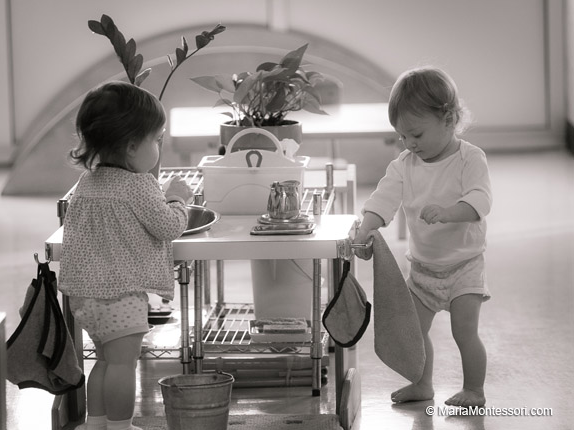
October 30, 2022
I recently visited a Montessori school in Arizona and had the opportunity to observe the toddler classroom. On this particular morning, there were eight children present, the youngest being 18 months of age and the oldest close to 30 months. It was toward the end of the morning, and the children were choosing their own activities. One little boy was using the colorful wooden rings of a stacking toy, while nearby another was working on his buttoning skills. Several children were engaged in art activities – coloring, pasting shapes on paper, and modeling clay – while others were matching objects to corresponding pictures. As it was near the end of the morning, an adult asked one little girl if she wanted to help set up for lunch. Boy! Did she? There were two long tables in the classroom, each with four chairs. Apparently, these were the lunch tables, for she went to the shelf and retrieved a tablecloth, and proceeded to cover one of these tables.
First, she unfolded the four feet of cloth, much longer than she was tall, then attempted to drape it as far onto the table as she could reach. Next, she toddled around to the far end of the table, to pull the tablecloth over. She leaned over the table, but couldn’t quite reach the edge. Undeterred, she returned to the first end and pushed the cloth a little farther across the surface of the table. Now when she circled to the other end and leaned over, she could just reach it. She gave it a tug. As you can probably guess, this time she pulled the tablecloth too far. This required that she once more return to the beginning and pull the tablecloth toward herself until it was fully extended and just hanging over both ends of the table by an equal amount. She patted the cloth 3 times, first at one end of the table, and then at the other. “Whew,” I thought, “that was a lot of work for a toddler!” But, to my surprise, she wasn’t nearly done.
Now she returned to the shelf to fetch a placemat. She selected a plaid one and put it on the tablecloth in front of one of the 4 chairs, and looked at it. For whatever reason, this plaid placemat just didn’t appeal to her. So, she returned it to the shelf and selected a solid beige one instead. Apparently, this satisfied her aesthetic sense, for she returned to the shelf three more times, and soon before each chair, there was a nice clean beige placemat.
She studied the table for a moment and then toddled back to the shelf for a plate. The plates were white ceramic ones and as she headed back to the table the teacher made one comment. “Please remember to carry the plates with two hands.” That’s all. No “Be careful that you don’t drop it!” Not even, “Oh what a good job you are doing!” As a result, she continued with her work undisturbed.
After four trips, each placemat held a ceramic plate. Now it was time to bring the glassware: one small juice glass for each placemat. Then she stood back and admired the table, but only for a moment, for there was another table to set! So, without further ado, she returned to the shelf and repeated the process of tablecloth, placemats, plates, and glasses for the second table.
But, she still wasn’t done! Now she began arranging lunchboxes. Apparently, each child sits in the same place at the table every day. So, this tiny child put the correct lunchbox by each of the chairs.
As she concluded her work, the teacher announced that it was time for the children to come to group time. It was also time for me to observe in a different classroom, so I retrieved my things and glanced at my watch before rising to go. I had been watching this one little girl for 30 minutes! And, did she look tired after her exertions? Not in the least. In fact, she looked refreshed and happy and she joined her group of friends, with the satisfaction of a job well done.
It occurred to me as I left that hardly anywhere else could this have happened except in a Montessori classroom. Where else would the adult have considered that such a tiny child could be capable of setting the table, and would actually want to? What took this little one 30 minutes to accomplish, an adult could have done in 3. In a few situations would the child have been allowed the uninterrupted time she required to accomplish this large task? In most situations, a well-meaning adult would have undoubtedly said, “Here, that’s too hard, let me do that for you” which might well have stopped this spontaneous expression of purpose and independence.
Only in a Montessori classroom.